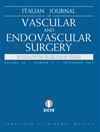Correlation of lipid profile and lipoprotein ratio with severity of diabetic foot ulcers
IF 0.2
Q4 PERIPHERAL VASCULAR DISEASE
Italian Journal of Vascular and Endovascular Surgery
Pub Date : 2023-10-01
DOI:10.23736/s1824-4777.23.01594-2
引用次数: 0
Abstract
BACKGROUND: Diabetic foot ulcers are the leading cause of amputation in non-traumatic patients. This study aimed to determine the correlation of lipid ratio levels with severity and treatment outcomes in diabetic foot ulcer patients, as well as the relationship of risk factors in diabetic foot patients with the severity of diabetic foot ulcers.METHODS: This cross-sectional study determined the correlation between the cholesterol ratios TG/HDL, LDL/HDL, and TC/HDL with the severity of diabetic foot ulcers according to the Wagner, Texas, and PEDIS classifications. The statistical analysis used the Pearson and Spearman correlation tests, which were deemed meaningful if P<0.05.RESULTS: The study participants were 42 diabetic foot ulcer patients aged 31 to 79 years. Out of the 42 patients, 39 had diabetic dyslipidemia. A significant positive correlation existed of triglyceride levels, TG/HDL ratio, duration of diabetes, and smoking history with the severity of diabetic foot according to the Wagner, Texas, and PEDIS classifications. A significant positive correlation was found of the TC/HDL ratio and TG/HDL ratio with the treatment outcome, as well as a significant negative correlation between the HDL level and treatment outcome.CONCLUSIONS: A significant correlation existed of low HDL, triglyceride, total cholesterol, and high TG/HDL ratio with the severity of diabetic foot. A greater duration of diabetes and a smoking history correlated with more severe diabetic foot. Low HDL and high TG/HDL and TC/HDL ratios were correlated with poorer treatment outcomes.脂质谱和脂蛋白比值与糖尿病足溃疡严重程度的相关性
背景:糖尿病足溃疡是导致非创伤性患者截肢的主要原因。本研究旨在确定脂质比值水平与糖尿病足溃疡患者严重程度及治疗结果的相关性,以及糖尿病足患者危险因素与糖尿病足溃疡严重程度的关系。方法:根据Wagner, Texas和PEDIS分类,本横断面研究确定TG/HDL, LDL/HDL和TC/HDL的胆固醇比率与糖尿病足溃疡严重程度之间的相关性。统计学分析采用Pearson和Spearman相关检验,P<0.05为有意义。结果:研究对象为42例31 ~ 79岁的糖尿病足溃疡患者。42例患者中,39例患有糖尿病性血脂异常。根据Wagner、Texas和PEDIS分类,甘油三酯水平、TG/HDL比值、糖尿病病程和吸烟史与糖尿病足的严重程度存在显著正相关。TC/HDL比值、TG/HDL比值与治疗结果呈显著正相关,HDL水平与治疗结果呈显著负相关。结论:低HDL、甘油三酯、总胆固醇和高TG/HDL比值与糖尿病足的严重程度存在显著相关性。糖尿病持续时间越长,吸烟史越严重,糖尿病足越严重。低HDL和高TG/HDL和TC/HDL比值与较差的治疗结果相关。
本文章由计算机程序翻译,如有差异,请以英文原文为准。
求助全文
约1分钟内获得全文
求助全文
来源期刊

Italian Journal of Vascular and Endovascular Surgery
PERIPHERAL VASCULAR DISEASE-
CiteScore
1.00
自引率
0.00%
发文量
27
审稿时长
>12 weeks
期刊介绍:
The Italian Journal of Vascular and Endovascular Surgery publishes scientific papers on vascular surgery. Manuscripts may be submitted in the form of editorials, original articles, review articles, case reports, therapeutical notes, special articles and letters to the Editor.
 求助内容:
求助内容: 应助结果提醒方式:
应助结果提醒方式:


